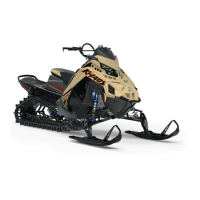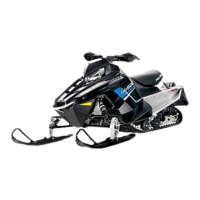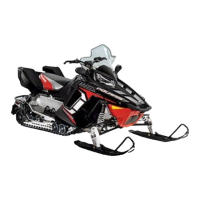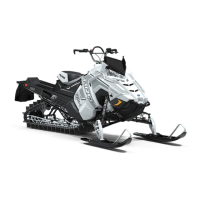2.10
GENERAL
Glossary Of Terms
ABDC: After bottom dead center.
ACV: Alternating current voltage.
Alternator: Electrical generator producing voltage
alternating current.
ATDC: After top dead center.
BBDC: Before bottom dead center.
BDC: Bottom dead center.
BTDC: Before top dead center.
CC: Cubic centimeters.
Center Distance: Distance between center of crankshaft
and center of driven clutch shaft.
Chain Pitch: Distance between chain link pins (No. 35 =
3/8" or 1 cm). Polaris measures chain length in number of
pitches.
CI: Cubic inches.
Clutch Buttons: Plastic bushings which aid rotation of the
movable sheave in the drive and driven clutch.
Clutch Offset: Drive and driven clutches are offset so that
drive belt will stay nearly straight as it moves along the
clutch face.
Clutch Weights: Three levers in the drive clutch which
relative to their weight, profile and engine RPM cause the
drive clutch to close and grip the drive belt.
Crankshaft Run-Out: Run-out or “bend” of crankshaft
measured with a dial indicator while crankshaft is
supported between centers on V blocks or resting in
crankcase. Measure at various points especially at PTO.
CVT: Continuously Variable Transmission (Drive Clutch
System)
DCV: Direct current voltage.
Dial Bore Gauge: A cylinder measuring instrument which
uses a dial indicator. Good for showing taper and out-of-
round in the cylinder bore.
Electrical Open: Open circuit. An electrical circuit which
isn't complete.
Electrical Short: Short circuit. An electrical circuit which
is completed before the current reaches the intended load.
(i.e. a bare wire touching the chassis).
End Seals: Rubber seals at each end of the crankshaft.
Engagement RPM: Engine RPM at which the drive clutch
engages to make contact with the drive belt.
ft.: Foot or feet.
ft-lb: (foot pounds) A force of one pound at the end of a
lever one foot in length, applied in a rotational direction.
g: Gram. Unit of weight in the metric system.
gal.: Gallon.
ID: Inside diameter.
in.: Inch/inches.
in-lb: (inch pounds) A force of one pound at the end of a
lever one foot in length, applied in a rotational direction. 12
in. lbs. = 1 ft. lb.
kg/cm
2
: Kilograms per square centimeter.
kg-m: Kilogram meters.
Kilogram/meter: A force of one kilogram at the end of a
lever one meter in length, applied in a rotational direction.
l or ltr: Liter.
lbs/in
2
: Pounds per square inch.
Left or Right Side: Always referred to based on normal
operating position of the driver.
m: Meter/meters.
Mag: Magneto.
Magnetic Induction: As a conductor (coil) is moved
through a magnetic field, a voltage will be generated in the
windings. Mechanical energy is converted to electrical
energy in the stator.
mi.: Mile/miles.
mm: Millimeter. Unit of length in the metric system. 1 mm
= approximately .040".
N-m: Newton meters.
OD: Outside diameter.
Ohm: The unit of electrical resistance opposing current
flow.
oz.: Ounce/ounces.
Piston Clearance: Total distance between piston and
cylinder wall.
psi.: Pounds per square inch.
PTO: Power take off.
qt.: Quart/quarts.
Regulator: Voltage regulator. Regulates battery charging
system output at approx. 14.5 DCV as engine RPM
increases.
Reservoir Tank: The fill tank in the liquid cooling system.
Resistance: In the mechanical sense, friction or load. In
the electrical sense, ohms, resulting in energy conversion
to heat.
RPM: Revolutions per minute.
Seized Piston: Galling of the sides of a piston. Usually
there is a transfer of aluminum from the piston onto the
cylinder wall.
Possible causes: 1) improper lubrication; 2) excessive
temperatures; 3) insufficient piston clearance; 4) stuck
piston rings.
Stator Plate: The plate mounted under the flywheel
supporting the battery charging coils.
TDC: Top dead center. Piston's most outward travel from
crankshaft.
Volt: The unit of measure for electrical pressure of
electromotive force. Measured by a voltmeter in parallel
with the circuit.
Watt: Unit of electrical power. Watts = amperes x volts.
WOT: Wide open throttle.
